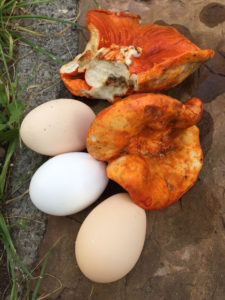It is a fascinating fact, albeit one that perhaps leans in the direction of TMI, that the manna from heaven which the Israelites relied upon for sustenance in their flight from Egypt was, according to some entomologists, the sweet gathered secretions of a scale insect that congregates in large numbers on tamarisk trees in the Middle East. It’s similar to the stuff I find under the box elder trees in early summer, the sticky, glittery honeydew of thousands of aphids all busy sucking sap from the leaves.
I haven’t gone so far as to try to gather that, although I’m sure it has some nutritive value. Nor have I gotten in the habit of frying up the grasshoppers that are easy to catch on our east-facing wall on summer days, though I know from time spent in Mexico they’re not bad with some chili and lime. My tastes in foraging tend more toward what grows directly out of the soil. But there I am an absolute sucker for anything tasty I can find out in the woods or along the streets that does not require me to pull out my wallet.
In August, we made our second attempt at finding lobster mushrooms under the ponderosa pines. Unlike the case with blackberries in Oak Creek, or apples in Flagstaff, I’m never really sure when to go. We made our first effort on a hot day in late July, after the first spate of good monsoon rains. The grasses were greened up, but the circles of duff under the pines remained inviolate, with none of the telltale humps where you can see some force pushing up from below. So, after a sweaty hour, we went back home, disappointed.
A few weeks later it was different. There had been more rains, and there was an extra layer of smell in the woods, a rich, moist wafting that incorporated the sweet scent of ponderosa pine bark, the tang of new leaves growing and the ferment of decay. It spoke simultaneously of growth and of rot, and seemed like the sort of atmosphere that a mushroom would want to poke its head into.
But that didn’t mean it was easy. In fact, we must have walked for 20 minutes or so thinking that this time, just as before, we’d get skunked. Pine needles stuck into our sandals; mosquitoes bothered our bare skin. “Can we go home now?” asked the 12-year-old. “I don’t think we’re going to find anything.”
It’s a weird feeling, walking around in the woods and not knowing if what you are looking for is going to pop out or not. It feels as though what happens has little to do with one’s own effort; rather, it is the world, or the place, deciding whether or not to reveal itself. The philosopher Ortega y Gasset has described this sense as well as anyone in an essay about hunting: “The hunter’s soul leaps out, spreads out over the hunting ground like a net, anchored here and there with the fingernails of his attention. Now everything is imminent and at any instant any figure of the countryside can become – as if by magic – the hunter’s prey.” Just like that, the place can come alive, just as a previously undifferentiated crowd of strangers can take on an intense new meaning when you spot within it the face of someone you love.
Not 30 seconds later it was the 12-year-old who exclaimed, “Well, looky there!” and excitedly knelt near a downed log. There it was, that intense weathered orange color, half-covered by brown needles. We slowed and looked more closely, wondering how many we’d walked by unknowingly.
Within ten minutes we’d gathered up a few pounds, each mushroom half covered with loam that we’d wash off on the back patio (old toothbrushes work well for this). Dinner that night would be mushrooms sautéed into an egg scramble. It would taste like the back yard.
It doesn’t matter that the time and effort expended to look for, find and clean the mushrooms far exceeds the time and effort needed to earn the amount of money that would buy an equivalent amount of mushrooms—and the same is true for local apples, or blackberries that I turn into jam, or dandelions and currants gathered from the backyard’s neglected edges. The foraging economy lives somewhere outside the money economy. It is not measured according to the same valuations. The pleasure it brings far exceeds the money value that the outside observer would assign to that bag of mushrooms or handful of greens.
It’s an odd thing, really. At this time of year I always try to remember to keep apples off the grocery list because surely we can find some free ones around town. When I’m putting the list together it is with the thought, well, we can save some money there. At first glance foraging seems like a great example of Something for Nothing, not so different from chancing upon a dollar bill on the sidewalk or a forgotten coupon for a free coffee and bagel.
But it’s not. It’s a trade. In these days when the all-too-common posture of pedestrians is head hunched down, trying to make out what’s on a small screen, it is easy to pass through the world as if we are barely present in the physical space we inhabit. It’s easy to walk around missing clues to the season, the level of humidity, what the plants are up to. Finding our own food outdoors is the world providing us with something useful—but not without an exchange. Foraging is the world pointing out that the resource of ours that has come to be in the shortest supply, and the one the world wants, is, precisely, our close attention.


